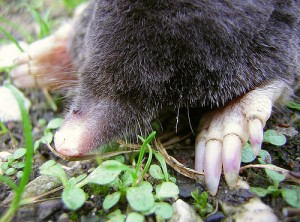 Mole Description and Habitats
Mole Description and Habitats
There are three types of moles found in the state of New York, the hairy tailed mole, the star nose mole and the eastern mole. The eastern mole is the most commonly found mole in the Hudson Valley of New York. Therefore we will focus on the eastern mole.
The eastern mole is about 3 ¼ to 8 ¾ “ long weighing 3 to 5 ounces. The eastern mole can have brown or gray fur with pink feet, noses and tails. They have very small eyes, no external ears, a naked, pointy snout and large front feet that are turned sideways having big claws that they utilize like a shovel.
Moles love to reside in lawns, meadow, orchards and woods with moist loose soil. They mostly eat insects, i.e. grubs, beetle larvae, earthworms and some carrion.
They must eat 70 to 100% of their body weight each day to have enough energy to burrow. Moles are polygamous. The female raises the young alone in an underground nest chamber lined with leaves and grasses. They breed in late February through March, with birthing occurring April to May, typically litter size being 3 to 7.
Moles Damage and Health Hazards
Moles are diggers. Many people believe that there is a mole in every tunnel they see, but the good news is, it’s probably just a couple of moles wreaking havoc on your lawn or garden. Moles can dig about 18ft/hour and they can tunnel up to 100 feet a day or more, depending upon soil conditions. Moles typically make two types of tunnels, feeder and travel tunnels. Keep in mind their digging is for insects, but inadvertently they tend to dig up and around the roots of your plants and grass and hence destroying them.
Mole Removal Services
Wildlife Busters recommends preventative measures in resolving historical nuisance mole issues. Moles are digging in your lawn or garden seeking food. Therefore, remove the food source ie treat your lawn with a grub pesticide, don’t over water your lawns and improve soil drainage – – wet ponding areas attracts insects ie worms. In the event you are already encountering mole issues, call us and Wildlife Busters will resolve your animal control issue by trapping and removing the mole. Once the moles have been removed, we will consult with you on ways to prevent them from coming back in the fall or next spring. Wildlife Busters prides itself on providing, professional, humane permanent solutions to human/wildlife conflicts.

 Receive FREE wildlife Tips!
Receive FREE wildlife Tips!
